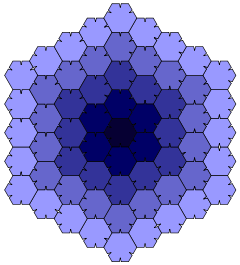
Heesch's problem
Encyclopedia

Heinrich Heesch
Heinrich Heesch was a German mathematician. He was born in Kiel and died in Hanover.In Göttingen he worked on Group theory. In 1933 Heesch witnessed the National Socialist purges among the university staff...
, concerns the maximum number of layers of congruent
Congruence (geometry)
In geometry, two figures are congruent if they have the same shape and size. This means that either object can be repositioned so as to coincide precisely with the other object...
copies of a geometric figure (usually a polygon
Polygon
In geometry a polygon is a flat shape consisting of straight lines that are joined to form a closed chain orcircuit.A polygon is traditionally a plane figure that is bounded by a closed path, composed of a finite sequence of straight line segments...
) that can surround that figure. For instance, a square may be surrounded by infinitely many layers of congruent squares in the square tiling, while a circle cannot be surrounded by even a single layer of congruent circles without leaving some gaps. In more complicated examples, such as the one shown here, a polygonal tile can be surrounded by several layers, but not by infinitely many; the maximum number of layers is the Heesch number of the tile. It is unknown whether or not the finite Heesch numbers are bounded. Casey Mann has constructed a family of tiles, each with the Heesch number 5, which is the highest known.
Formal definitions
A tessellationTessellation
A tessellation or tiling of the plane is a pattern of plane figures that fills the plane with no overlaps and no gaps. One may also speak of tessellations of parts of the plane or of other surfaces. Generalizations to higher dimensions are also possible. Tessellations frequently appeared in the art...
of the plane is a partition of the plane into smaller regions called tiles. The zeroth corona of a tile is defined as the tile itself, and for k > 0 the kth corona is the set of tiles sharing a boundary point with the (k − 1)th corona. The Heesch number of a figure S is the maximum value k such that there exists a tiling of the plane, and tile t within that tiling, for which that all tiles in the zeroth through kth coronas of t are congruent to S. In some work on this problem this definition is modified to additionally require that the union of the zeroth through kth coronas of t is a simply connected region.
If there is no upper bound on the number of layers by which a tile may be surrounded, its Heesch number is said to be infinite. In this case, an argument based on König's lemma
König's lemma
König's lemma or König's infinity lemma is a theorem in graph theory due to Dénes Kőnig . It gives a sufficient condition for an infinite graph to have an infinitely long path. The computability aspects of this theorem have been thoroughly investigated by researchers in mathematical logic,...
can be used to show that there exists a tessellation of the whole plane by congruent copies of the tile.
Example
Consider the non-convex polygon P shown in the figure, which is formed from a regular hexagon by adding projections on two of its sides and matching indentations on three sides. The figure shows a tessellation consisting of 61 copies of P, one large infinite region, and four small diamond-shaped polygons within the fourth layer. The first through fourth coronas of the central polygon consist entirely of congruent copies of P, so its Heesch number is at least four. One cannot rearrange the copies of the polygon in this figure to avoid creating the small diamond shaped polygons, because the 61 copies of P have too many indentations relative to the number of projections that could fill them. By formalizing this argument, one can prove that the Heesch number of P is exactly four. According to the modified definition that requires that coronas be simply connected, the Heesch number is three. This example was discovered by Robert AmmannRobert Ammann
Robert Ammann was an amateur mathematician who made several significant and groundbreaking contributions to the theory of quasicrystals and aperiodic tilings....
.

